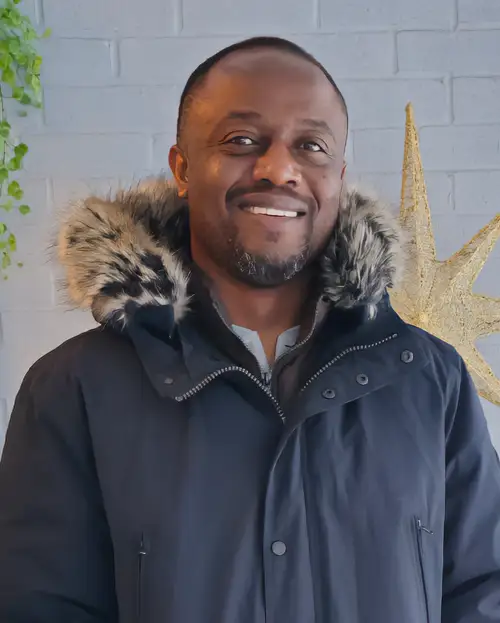
Patrick’s story
Parafalcine meningioma, craniotomy
'I wanted to know what was wrong with me'
Patrick's attitude about surgery started to change after he saw an image of his brain on the monitor – with a mass larger than a golf ball lodged between the two hemispheres.
Beset by headaches that were getting worse, Patrick had nonetheless resisted any talk of surgery. Medicine had helped with the headaches before, and he was anxious about what the impact of surgery might be.
After seeing the image and talking to Dr. Yair Gozal, a neurosurgeon at Mayfield Brain & Spine, Patrick realized how serious his condition had become – yet he was grateful.

Patrick's MRI showed a large meningioma along the falx (dura fold between the right and left hemispheres) causing significant swelling of the brain.
"When I saw the mass, it was a little scary," he said. "But at least it gave me some peace of mind, because I wanted to know what was wrong with me."
More than a year before the surgery, Patrick had started having new headaches, an important signal to the medical team. Most patients with this type of tumor suffer through headaches daily, often worse in the mornings.
Over a period of months, the painkillers did not work as well. Doctors suggested an MRI scan of Patrick's brain that showed the large mass. They advised him to go to the emergency room, but he didn't go because he needed to keep working to support his wife and two children.
"I was nervous about everything, even when there was nothing to be nervous about," he said. "I'm telling you, it was very hard on my family, on all of us."
In early 2024, Patrick underwent a five-hour procedure to remove the tumor in an operation called a craniotomy, through an incision starting above Patrick's right ear and extending above the hairline across his forehead.
"Patrick's tumor was large and was causing a lot of swelling in the surrounding brain," Dr. Gozal said. "Surgery to remove the tumor was an obvious next step, particularly for a young person who needed to keep providing for his family.
His headaches were only the first signal. As the tumor continued to grow, he would be susceptible to other symptoms, such as seizures or cognitive issues, that would affect his ability to function and enjoy a healthy life."
Originating in the lining of the brain, meningiomas are generally benign tumors that grow slowly. When they become large enough, they can affect both the brain itself and adjacent structures, impinging on important functions including vision, motion, sensation and emotional control, depending on the location of the tumor.

Since the operation, Patrick says he has "never had a headache." With the uncertainty about his symptoms gone, he doesn't feel as anxious about small things.
"I just needed someone to help me find the answers," he said.
Dr. Gozal said the retro-orbital headaches, located behind the right eye, were caused by the size of the tumor and the pressure it was causing.
"Many patients just want to have certainty, to find an explanation for their symptoms that makes sense to them," he said.
"We stressed to Patrick that each of these issues linked directly to the mass pressing against his brain."
Today, Patrick is grateful that they had those conversations and for his bond with Dr. Gozal. The two even spoke French during appointments. Patrick is from the Democratic Republic of the Congo, while Dr. Gozal is a triple citizen of the U.S., France and Israel.
"I was fearing for my life and worried about my family," Patrick said. "Dr. Gozal really calmed me down. He's humble and he understands people. I pray for him so that he will save other people who have the same issues as I had."
~ Cliff Peale
Hope Story Disclaimer -"Patrick's Story" is about one patient's health-care experience. Please bear in mind that because every patient is unique, individual patients may respond to treatment in different ways. Results are influenced by many factors and may vary from patient to patient.
